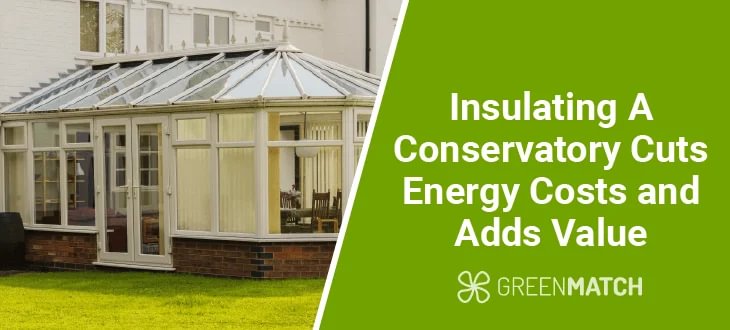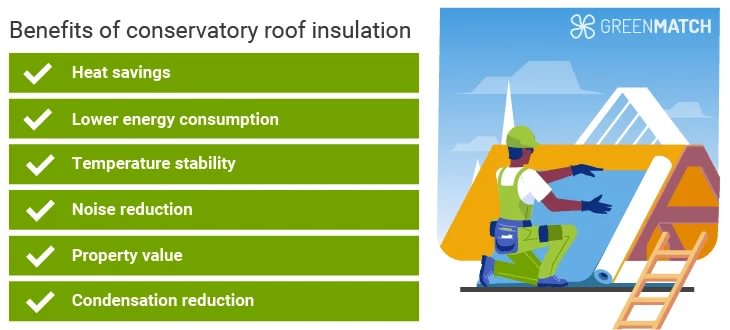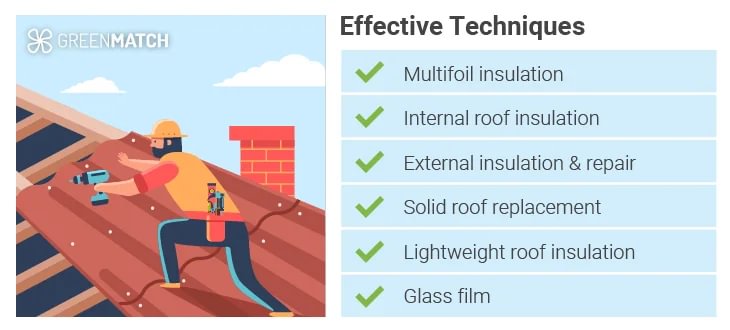Answer these simple questions and we will find you the BEST prices
Which type of solar quotes do you need?
It only takes 30 seconds
100% free with no obligation

Get Free quotes from insulation specialists near you

Save money by comparing quotes and choosing the most competitive offer

The service is 100% free and with no obligation
- GreenMatch
- Insulation
- Conservatory Insulation
- Conservatory Roof Insulation
A Complete Guide to Conservatory Roof Insulation (2025)


- Effective conservatory roof insulation can retain up to 90% of heat during winter, reduce energy consumption, and improve overal comfort.
- Several options are available for insulating conservatory roofs to suit different budgets and energy efficiency objectives.
- The cost of insulating a conservatory roof can vary significantly, typically ranging from £500 to £10,000. Several factors influence the price, including the chosen insulation method, materials used, and the size of the conservatory.
Insulating your conservatory's roof offers numerous essential benefits. It enhances year-round comfort, making the space more usable in all seasons.
Energy efficiency is improved by reducing heat loss in winter and heat gain in summer, lowering energy bills and reducing the carbon footprint. A well-insulated conservatory also increases property value by making it more functional and energy-efficient.
Ready to insulate your home? Let GreenMatch UK take care of your time-consuming research and selection process. Instead of wasting hours browsing websites and making phone calls to installers, just take 30 seconds to fill out our online form. We’ll provide up to 3 customised quotes from professional installers in your local area - completely free. Click below to get started!
- Describe your needs
- Get free quotes
- Choose the best offer
It only takes 30 seconds



Benefits of conservatory roof insulation

Roof insulation for a conservatory provides substantial environmental benefits by reducing energy consumption, which leads to a smaller carbon footprint. This is achieved by significantly reducing heat loss during winter and minimising heat gain in summer, which decreases the need for heating and cooling systems.
- Heat savings: Insulating a conservatory roof can save considerable heat. Effective insulation can retain up to 90% of heat during winter, making the space more energy-efficient and comfortable.
- Lower energy consumption: Reduced energy consumption translates to a smaller carbon footprint. With insulation for conservatory roofs, the space remains warmer in winter and cooler in summer, thus reducing the reliance on energy-intensive heating and cooling systems.
- Stable temperature: Conservatory insulation ensures a more stable temperature throughout the year, making the space more comfortable and usable. This is particularly effective with internal conservatory roof insulation, significantly enhancing thermal performance.
- Noise reduction: Insulating a conservatory roof also reduces noise, particularly from rain, enhancing the space's overall comfort and usability.
- Increased property value: A well-insulated conservatory can increase property value by improving energy efficiency and providing a more comfortable, usable space throughout the year.
Condensation reduction: Insulating a conservatory roof helps reduce condensation, which prevents mould and maintains a healthier indoor environment.
How to insulate a conservatory roof
Various methods exist for Insulating your conservatory roof, each with its benefits and considerations. We will explore the most common and effective techniques, including multifoil insulation, internal and external insulation, and glass film application. Understanding these options allows you to make informed decisions to improve your conservatory’s performance and sustainability.

Multifoil insulation
Multifoil insulation involves using materials like EcoQuilt Expert or YBS SuperQuilt. This method is highly effective in maintaining temperature due to its reflective layers, which reduce heat loss in winter and heat gain in summer. It is also lightweight and easy to install, making it a sustainable option.
Pros
- Excellent thermal performance due to multiple reflective layers.
- Lightweight and easy to install, often DIY-friendly.
- Reduces heat loss in winter and heat gain in summer, maintaining a stable temperature.
Cons
- Higher initial cost compared to traditional insulation materials.
- Additional internal finishing may be required to achieve a polished look.
- Requires careful installation to ensure maximum effectiveness.
Internal conservatory roof insulation
Internal conservatory roof insulation includes installing insulation materials directly beneath the roof. This method involves stapling multifoil to battens and sealing with foil tape. It enhances thermal performance and comfort.
Pros
- ImproveS thermal efficiency, making the conservatory usable year-round.
- Reduced condensation, which helps prevent mould growth.
- Enhances the aesthetic by covering existing roof structures.
Cons
- Installation can be complex and may require professional assistance.
- Reduces ceiling height slightly, impacting headroom.
- May require ongoing maintenance to ensure insulation remains effective.
External insulation and roof repair
External insulation involves applying insulating materials on the exterior roof surface. Combined with roof repairs, this method can significantly enhance the conservatory's thermal performance and extend the roof's lifespan.
Pros
- Protects the roof structure from weather damage, extending its lifespan.
- Provides an excellent thermal barrier.
- Enhances the external appearance if done aesthetically.
Cons
- Higher installation complexity and cost often require professional contractors.
- Possible alteration of the conservatory's external appearance.
- Planning permissions may be required depending on local regulations.
Glass film
Glass film is a reflective material applied to the conservatory's glass roof. It reduces solar gain and glare, helping keep the summer conservatory cooler.
Pros
- Reduces solar heat gain and glare, making the conservatory more comfortable in summer.
- Relatively easy to apply and can be a DIY project.
- Maintains natural light levels while improving thermal performance.
Cons
- Less effective at retaining heat during the winter months.
- May need to be replaced periodically as it can wear out over time.
- Less effectiveness compared to more substantial insulation methods.
Replacing polycarbonate roof with a solid roof
When replacing a polycarbonate roof with a solid roof, such as slate or tile, assessing the conservatory's structural integrity is crucial before replacing the roof. The existing frame must support the additional weight of a slate or tile roof. Consulting with a structural engineer or a professional conservatory specialist can ensure that any necessary reinforcements are made to avoid structural issues.
Pros
- Solid roofs provide superior thermal insulation
- Slate and tile roofs are long-lasting, durable and weather-resistant, requiring less maintenance.
- They enhance the conservatory's overall look, matching it closer to the rest of the house.
Cons
- Expensive, with higher initial costs for materials and installation.
- The conservatory's frame must be strong enough to support the added weight of a solid roof, and reinforcements may be necessary.
- Requires professional installation due to the complexity and weight of the materials.
Lightweight internal roof insulation
Conservatory ceiling insulation involves adding lightweight internal insulation to enhance a conservatory's thermal efficiency and comfort. This method is significantly cheaper than installing a solid roof but less effective in insulation performance.
Lightweight internal roof insulation uses materials like multifoil or insulation boards installed beneath the existing roof structure. These materials reflect heat into the room, reducing heat loss in winter and heat gain in summer.
Pros
- Cheaper than replacing the roof with solid materials.
- Often suitable for DIY projects, reducing labour costs.
- Reduces drafts and condensation, making the conservatory more comfortable year-round.
Cons
- Solid roofs provide a different level of insulation than they are, resulting in lower energy efficiency.
- May alter the appearance of the interior ceiling, depending on the materials used.
- May not last as long as more robust insulation solutions, potentially requiring frequent replacement.
Conservatory roof insulation cost in the UK
The cost of conservatory roof insulation in the UK can vary significantly depending on the type of insulation used and the size and complexity of the project. Here's a detailed breakdown of the costs associated with different insulation methods:
| Method | Cost range |
|---|---|
| Replacing polycarbonate with a solid roof | £5,500 - £10,000 |
| Multifoil insulation | £1,000 - £2,500 |
| External insulation and roof repair | £3,000 - £6,000 |
| Window film | £500 - £1,500 |
| Thicker polycarbonate panels | £1,500 - £3,500 |
| Triple glazing | £2,500 - £5,000 |
Several factors can influence the conservatory insulation cost, making it essential to consider each one carefully when planning your project. The size of the conservatory, the type of insulation material, the complexity of installation, and the need for any structural modifications all play a significant role in determining the final price.
Additionally, geographic location and the choice of installer can affect costs, as labour rates and material expenses can vary widely across different regions and providers.
Conservatory roof insulation grants
In the UK, homeowners may be eligible for insulation grants to help with the cost of conservatory roof insulation through schemes like the Energy Company Obligation (ECO). The ECO scheme is designed to help reduce carbon emissions and tackle fuel poverty by providing financial assistance for energy efficiency improvements, including insulation for conservatory roofs.
The ECO scheme is available to homeowners and tenants who receive certain benefits. This scheme may cover part or all of the cost of conservatory roof insulation. To apply, interested individuals should contact participating energy suppliers or visit government websites for more information.
DIY conservatory roof insulation

In some cases, insulating your conservatory roof can be a DIY project. Methods like installing thermal blinds, roof drapings, or using conservatory roof insulation kits are great options for DIY enthusiasts. Thermal blinds and roof drapings help reduce heat loss and gain, improving comfort. Alternatively, insulation kits such as EcoQuilt Expert or SuperQuilt provide an easy-to-install solution, with all materials and instructions included for a straightforward setup.
Professional installation is recommended in cases where the conservatory roof requires structural modifications, such as reinforcing the frame to support heavier insulation materials like solid roofs. Additionally, professionals should handle complex installations involving electrical work or intricate design changes to ensure safety and compliance with building regulations.
Hiring a professional is advisable for more complex insulation needs, such as installing conservatory roof insulation panels or retrofitting with a solid roof. Professional installers have the expertise to ensure the job is done correctly and safely, potentially avoiding costly mistakes.
What is the best insulation for a conservatory roof?
Determining the best roof insulation for a conservatory depends on various factors, including specific priorities, budget, and desired effectiveness. Let’s take a look at the different options:
- Multi-foil insulation: Multi-foil insulation effectively reduces heat loss significantly and reflects solar radiation. It is relatively easy to install and offers a good balance of cost and performance.
- Solid roof replacement: This method offers the best insulation by achieving U-values similar to house roofs, but it is expensive, typically ranging from £5,000 to £10,000.
- Thermal conservatory roof insulation: Adding thermal insulation to the existing roof is practical and affordable, suitable for DIY conservatory roof insulation installation, and provides decent performance without needing professional help.
- Solar film: This budget-friendly option reduces solar gain effectively, helping to prevent overheating during the summer.
- Reflective foil with laminate underlay: This low-cost, DIY-friendly method for minor insulation improvements is ideal for temporary solutions.
- Blinds and drapes: Heavy fabric curtains or thermal blinds can prevent heat loss through windows and enhance the conservatory's appearance, with costs varying based on quality.
Is conservatory insulation worth it?
Conservatory roof insulation is worth the investment due to its numerous benefits. Sustainability benefits include reduced energy consumption and a lower carbon footprint, as insulated conservatories require less heating in winter and cooling in summer. Financially, insulation can lead to significant savings on energy bills over time, enhancing the overall value of your home.
By improving thermal efficiency, insulation makes the conservatory usable year-round, increasing comfort and reducing noise. For optimal results, consider consulting conservatory insulation installers near you to get accurate quotes and professional advice.
Complete our online form in just 30 seconds, and we'll deliver up to 3 free personalised quotes from professional installers in your area. Click below to get started!
- Describe your needs
- Get free quotes
- Choose the best offer
It only takes 30 seconds



FAQ
The best insulation depends on your priorities and budget. Insulated roof panels offer excellent thermal performance and durability, while multifoil insulation is a more cost-effective solution. Consult with local conservatory roof insulation installers near you to find the best fit for your needs.
Yes, it is safe to insulate a conservatory roof, provided that the materials and installation methods used comply with building regulations. Professional installation ensures safety and effectiveness, especially for more complex projects.
Yes, putting a warm roof on a conservatory is worth it. It significantly improves thermal efficiency, making the space comfortable year-round, reducing energy bills, and increasing property value.
Yes, grants are available through schemes like the Energy Company Obligation (ECO), which may cover part or all of the insulation cost for eligible homeowners and tenants receiving certain benefits. Check with local authorities or energy suppliers for more information.
The cheapest way to insulate a conservatory roof is with window film or thermal blinds. These methods are affordable and easy to install, though they offer less insulation than more substantial options like insulated roof panels or multifoil insulation.

Nicole Bea Kerr is a content writer for Greenmatch, leveraging her experience in B2B journalism and editing. She is interested in bringing more awareness to sustainability through informative narratives.
We strive to connect our customers with the right product and supplier. Would you like to be part of GreenMatch?

